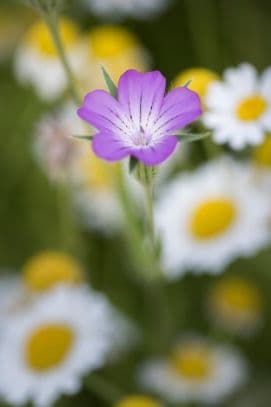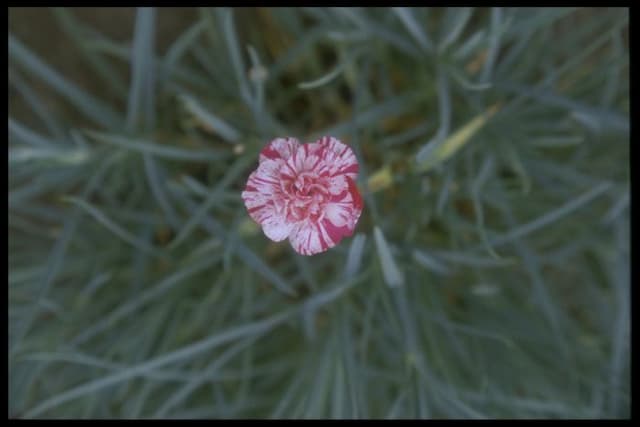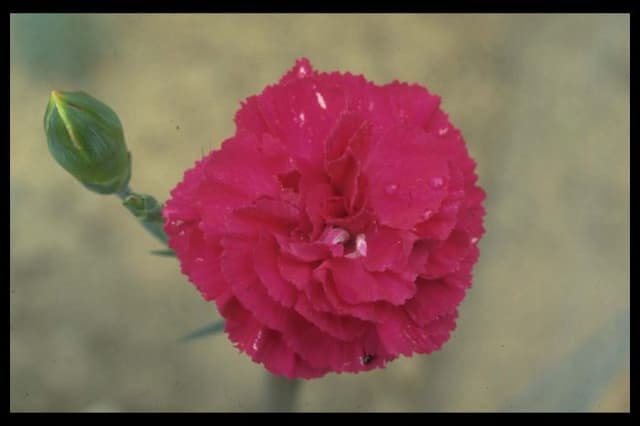Baby's breath Gypsophila paniculata 'Flamingo' (d)

ABOUT
The 'Flamingo' cultivar of baby's breath is a captivating ornamental plant that displays an array of delicate blooms. It is characterized by its profusion of small, light pink flowers that form a frothy, cloud-like mass. The flowers are clustered on thin, branching stems, lending an airy, ethereal quality to the plant's overall appearance. Its leaves are a gray-green color, narrow, and lance-shaped, providing a soft backdrop that makes the pink flowers stand out even more prominently. Together, the blooms and foliage create a whimsical, romantic effect that is favored in garden landscapes. The 'Flamingo' variety, specifically, may have a slightly bolder hue of pink compared to the classic white blooms commonly associated with baby's breath. These charming pink flowers are often used in floral arrangements and as filler in bouquets, where they add volume and a touch of whimsy. Additionally, when the plant is in full bloom, it attracts various pollinators, adding to the lively ambiance in any garden setting where it is planted.
About this plant
 Names
NamesFamily
Caryophyllaceae
Synonyms
Baby's Breath, Gyp, Bristol Fairy
Common names
Gypsophila paniculata.
 Toxicity
ToxicityTo humans
Baby's breath, typically, is not considered toxic to humans. However, as with any plant, individual allergic reactions or sensitivities could occur in some people. Ingesting significant amounts of the plant is not advised, as it could potentially cause gastrointestinal discomfort or an upset stomach due to the unusual plant matter, but no specific toxic elements are noted in general literature about its use in floral arrangements and gardens.
To pets
Baby's breath is generally not considered highly toxic to pets. However, ingestion of this plant may still lead to mild gastrointestinal upset in some pets, such as vomiting or diarrhea. If your pet consumes a large amount, or if you notice any unusual symptoms after ingestion, it is recommended to consult a veterinarian. It is always best to keep plants out of reach of pets, especially if they are known to nibble on them.
 Characteristics
CharacteristicsLife cycle
Perennials
Foliage type
Deciduous
Color of leaves
Green
Flower color
Pink
Height
2-3 feet (60-91 cm)
Spread
2-3 feet (60-91 cm)
Plant type
Herb
Hardiness zones
3
Native area
Europe
Benefits
 General Benefits
General Benefits- Attractive Flowers: Gypsophila paniculata 'Flamingo', commonly known as Baby's Breath, produces delicate and airy clusters of small, light pink to white blooms that add a soft and romantic feel to gardens and floral arrangements.
- Drought Tolerance: Baby's Breath is relatively drought-tolerant, making it suitable for gardens in drier climates or areas with water restrictions.
- Low Maintenance: This plant requires minimal upkeep once established, with occasional watering and trimming back after flowering to encourage new growth.
- Soil Adaptability: It can thrive in a range of soil conditions, from clay to sandy soils, as long as they are well-draining.
- Pest Resistance: Baby's Breath is less susceptible to many common garden pests, reducing the need for chemical interventions.
- Attracts Beneficial Insects: The flowers of Baby's Breath are known to attract butterflies and bees, promoting pollination in the garden.
- Versatile Use: This plant is widely used in both fresh and dried floral arrangements due to its longevity after cutting and its ability to add volume and texture.
- Garden Structure: Its mounded form and frothy blooms can provide structure and contrast when planted among other perennials and shrubs in a garden setting.
- Plant Propagation: Baby's Breath can be easily propagated from cuttings or seeds, allowing gardeners to expand their plantings without additional cost.
- Seasonal Interest: Offering an extended blooming period from early summer to fall, Baby's Breath helps ensure that gardens have enduring visual appeal throughout the growing season.
- Border Planting: Due to its compact size, Baby's Breath works well as an edging or border plant, delineating garden spaces with its light, textural flowers.
 Medical Properties
Medical PropertiesThis plant is not used for medical purposes.
 Air-purifying Qualities
Air-purifying QualitiesThis plant is not specifically known for air purifying qualities.
 Other Uses
Other Uses- Gypsophila 'Flamingo', commonly known as baby's breath, can be used as a natural dye source, providing subtle shades of beige or pale pink when used in the fabric dyeing process.
- The plant's stems are flexible when young and can be woven into small wreaths or decorative shapes for crafts or jewelry making.
- Dried baby's breath, due to its lightness and volume, is sometimes used in creating 3D art projects and dioramas to mimic bushes or cloud-like textures.
- Crushed stems of baby's breath can be added to homemade paper mixtures to create textured paper for art projects or specialty stationery.
- The tiny flowers can be incorporated into handmade potpourri mixes, adding a delicate, romantic visual element to the blend.
- Juice from the stems of baby's breath, when mixed with other ingredients, can be used as a natural adhesive or binder in paper mache and other crafting applications.
- Baby's breath can be floated in large decorative bowls or vases as part of a table centerpiece, especially for weddings or other romantic events.
- When dried, the delicate flower clusters can be used to fill transparent ornaments for a rustic or whimsical Christmas tree decoration.
- The plant is sometimes incorporated into living walls or vertical gardens due to its fine texture and ability to add depth and contrast against other foliage.
- Baby's breath is used in the culinary field as a decorative edible garnish for desserts and drinks, though it is not known for any particular flavor.
Interesting Facts
 Feng Shui
Feng ShuiThe Baby's Breath is not used in Feng Shui practice.
 Zodiac Sign Compitability
Zodiac Sign CompitabilityThe Baby's Breath is not used in astrology practice.
 Plant Symbolism
Plant Symbolism- Innocence - Gypsophila, commonly known as Baby's Breath, often symbolizes innocence due to its delicate and dainty blooms, which evoke a sense of purity and untainted beauty typically associated with newborns and children.
- Love - The ubiquity of Baby's Breath in bridal bouquets and wedding decorations has made it an emblem of love and the unification of two people, representing the enduring bond and commitment of a romantic relationship.
- Purity - Reflecting the white color of its most common variety, Baby's Breath is associated with purity. Its clean and airy appearance is often used to represent a clean slate or the pure intentions of one's heart.
- Eternal Love - Because Baby's Breath is a popular choice in weddings and it also dries very well, maintaining its appearance over time, it has come to symbolize everlasting love that stands the test of time.
- Compassion - Some interpretations include Baby's Breath as a sign of compassion and empathy, with the small and numerous flowers representing a multitude of kind and heartfelt gestures.
- Freedom - The light and airy form of Baby's Breath can also represent freedom—the ability of the individual flowers to move independently in the breeze embodies a sense of liberation and free spirit.
 Water
WaterBaby's Breath requires consistent moisture, but it is important to avoid overwatering. Water the plant deeply once a week, allowing the soil to dry out slightly between waterings. During hot, dry periods, you may need to water twice a week, ensuring that you provide about one gallon of water each time. Avoid getting water on the foliage to prevent leaf diseases. In well-drained soil, Baby's Breath will need less frequent watering, but always check the top inch of soil for dryness as your guide.
 Light
LightBaby's Breath thrives best in full sunlight where it can receive at least six hours of direct, unfiltered sunlight daily. The ideal spot for growing Baby's Breath is in an open area away from shade-casting trees or buildings. Partial shade is tolerable, but flowering might be less abundant compared to a full sun location.
 Temperature
TemperatureBaby's Breath grows best in temperate conditions and can generally handle temperatures between 40 and 80 degrees Fahrenheit. It is not frost-tolerant and should be protected from temperatures below 40 degrees Fahrenheit. The ideal growing temperature for Baby's Breath is within the range of 60 to 70 degrees Fahrenheit.
 Pruning
PruningBaby's Breath should be pruned to encourage bushier growth and more blooms. After the first flush of flowers fades, cut the plant back by one-third to promote a second bloom period. The best time to prune Baby's Breath is in late winter or early spring, when new growth begins but before the plant starts to bloom. Pruning can be done annually to maintain the desired shape and size.
 Cleaning
CleaningAs needed
 Soil
SoilBaby's Breath prefers well-draining soil with a mix of one part garden soil, one part compost, and one part coarse sand or perlite. The ideal soil pH for Baby's Breath is between 6.5 to 7.0.
 Repotting
RepottingBaby's Breath should be repotted every 1 to 2 years to refresh the soil and accommodate root growth; however, this perennial plant often performs best when not frequently disturbed.
 Humidity & Misting
Humidity & MistingBaby's Breath thrives in average humidity conditions and does not require high humidity levels to grow well.
 Suitable locations
Suitable locationsIndoor
Place Baby's Breath in a sunny spot with good air flow.
Outdoor
Plant Baby's Breath in full sun and well-drained soil.
Hardiness zone
3-9 USDA
 Life cycle
Life cycle'Flamingo' baby's breath (Gypsophila paniculata 'Flamingo') starts its life cycle as a seed, which germinates in early spring when soil temperatures warm up. Upon germination, seedlings emerge and grow into rosettes of narrow, lance-shaped leaves. As it matures, a strong root system develops, and the plant begins to send up multiple branching stems, which become covered in tiny, cloud-like pink to white flowers during the summer months. After pollination, typically by insects, the plant sets seed in small capsule-like fruits that, once dry, release seeds for the next generation. Throughout its growing season, Flamingo baby's breath can experience multiple flushes of bloom, especially if spent flowers are deadheaded. With the onset of colder weather, the plant dies back to its root system, lying dormant through the winter to restart the cycle again the following spring.
 Propogation
PropogationPropogation time
Spring-Early Summer
Gypsophila paniculata 'Flamingo', commonly known as the Flamingo Baby's Breath, is most commonly propagated through seed sowing. The ideal time to sow seeds is in late winter to early spring, ensuring they are started indoors 6 to 8 weeks before the last frost date. Sow seeds shallowly, just covering them with a thin layer of soil as they need light to germinate. Moisten the soil and maintain a temperature of about 70°F (21°C). Seedlings usually emerge in 10 to 20 days, at which point they should be gradually acclimatized to outdoor conditions before transplanting them to their permanent locations in the garden. This method is popular as it is straightforward and allows for the production of many plants at a relatively low cost. It's important to keep the young plants well-watered and to space them adequately to ensure good air circulation as they grow.









